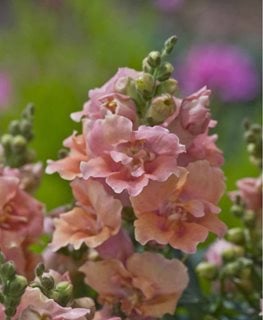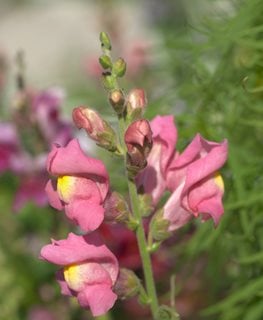How to Grow Snapdragon Flowers
Learn how to plant, grow, and care for these colorful cool-season annuals.The snapdragon is one of those old-fashioned flowers that only gets better with time. If you haven’t shopped around for snapdragon plants or seeds recently, you’ll be amazed at what the latest hybrids have to offer, including a wider array of colors, growth habits, and height options, ranging from as little as a few inches to several feet. You can even find trailing snapdragons perfect for hanging baskets and window boxes.
What hasn’t changed over the years is the snapdragon’s affinity for cool weather, which is why it continues to be a mainstay for adding bold pops of color to the garden in early spring and fall. Today, you can also find heat-tolerant snapdragon varieties that will bloom like mad all the way until the first frost, even during the hottest days of summer.
On this page: Basics | Types | Planting | Care | Pictures | Design Ideas
On this page:
- BASICS
- TYPES OF SNAPDRAGONS
- PLANTING SNAPDRAGONS
- SNAPDRAGON CARE
- SNAPDRAGON PICTURES
- DESIGN IDEAS
- FREQUENTLY ASKED QUESTIONS
BASICS
Botanical name:
Antirrhinum majus
Plant type
Short-lived perennial, usually grown as an annual
Zones:
7-11
Exposure
Full sun to part shade
Height:
Available in a range of heights, including dwarf (4 to 6 inches tall), short (9 to 12 inches tall), intermediate (1 to 2 feet tall), and tall (2 to 4 feet tall).
Habit:
May be low-growing and mound-forming, tall and spiky, or trailing, depending on the variety.
Bloom period:
Early spring through fall. In southern climates where winters are mild, they will bloom in winter and spring.
Flowers:
Blooms in nearly every color except true blue, including showy bi-colored and tri-colored varieties. The flowers may be open-faced, traditional (with a hinged “jaw” that opens like a dragon’s mouth when pinched), or double (also known as azalea snapdragons).
Special attributes:
- Cold tolerant
- Deer and rabbit resistant
- Attracts bees, butterflies, and hummingbirds
- Fragrant flowers
- Excellent for cutting
What about summer snapdragons?
Don’t confuse snapdragons with angelonia plants (Angelonia angustifolia), also known as “summer snapdragons.” Although the two flowers are similar in appearance, angelonias, unlike most snapdragons, thrive in summer heat.
TYPES
Plant breeders assign group numbers to snapdragons based on their day length needs and bloom seasons. Group numbers range from 1 to 4, with some overlap of groups.
- Groups 1 and 2: Cool-season snapdragons prefer shorter days and lower light levels. Grow in fall, winter, and early spring.
- Group 3: Moderate to warm-season snapdragons grow well in medium to long days, moderate light levels, and warmer temperatures. Grow in spring, summer, and fall.
- Group 4: Warm-season snapdragons prefer higher light levels, longer days, and warmer temperatures. They grow slower and take longer to bloom. Grow in spring and summer.
To enjoy the longest bloom window possible, consider growing snapdragon varieties from each of the four groups, with Group 1 plants being the earliest to flower.
PLANTING SNAPDRAGONS
When to plant:
Since most snapdragons perform best in the cooler months, the best time to plant them is in early spring (colder climates) or fall (warmer climates). Because they will tolerate light frosts, they can be set out in the spring garden a week or two before the average last frost date in your area. In hot climates (zones 8-11), put plants in the ground by the end of November for winter and early spring blooms.
Where to plant:
Snapdragons bloom best when they have full sun exposure (at least 6 hours daily), but will also grow well in a partially shaded location, especially in hotter climates.
How to plant:
When growing snapdragons from nursery starts, dig a hole just slightly larger than the plant’s root ball. Carefully remove the plant from its container and place it in the hole so the top of the root ball is level with the surrounding soil. Backfill with soil, gently pressing it into place, and water thoroughly. Space plants 6 to 12 inches apart (depending on their size at maturity) to allow enough room for branching and the production of multiple stems.
Soil:
Plants prefer moist, well-drained soil rich in organic matter. Although they will tolerate clay and sandy soils, they may not perform as expected.
Growing from seed:
Growing snapdragons from seed gives you a much broader selection of plants to choose from, including hard-to-find heirloom varieties. It’s best to sow the seeds indoors 8 to 10 weeks before the final spring frost in your area so you have a longer time to enjoy the blooms before the heat of midsummer arrives. In mild climates (zones 7 to 11), you can sow the seeds outdoors in late fall or winter for early spring blooms.
Because snapdragon seeds need light to germinate, press them firmly into the soil but do not cover. Keep the soil evenly moist, and place the seed trays in a warm location (60° to 70°F) under grow lights or fluorescent lighting. Once the seedlings develop a few sets of leaves, gradually acclimate them to outdoor conditions before transplanting them into the garden. After the transplants are established, pinch them back at the tips by an inch or two to encourage branching.
Planting in containers:
All but the tallest varieties of snapdragons grow well in containers, especially dwarf and trailing types. Be sure to choose a container that drains well and use a high-quality, all-purpose potting mix. Because snapdragons often take a break from blooming during the heat of the summer, they are best suited for early spring and fall container plantings, paired with other cool-weather annuals such as pansies, sweet alyssum, African daisy (Osteospermum), dianthus, and lobelia.
Propagation:
From seed, stem cuttings, or root division. Note that seeds from cultivated varieties may not grow true to type.
SNAPDRAGON CARE
Watering:
Water snapdragon plants regularly the first few weeks after planting to keep the soil evenly moist. Once the roots become established, you should give your plants about an inch of water per week during periods of no rainfall. If the top inch of soil feels dry to the touch, it’s time to water. To prevent fungal diseases, avoid overhead watering and water early in the day so the foliage has a chance to dry before nightfall.
Amendments and fertilizer:
Because snapdragons like to put down roots in rich, well-draining soil, amend the soil at planting time with plenty of compost
Once the flower stalks begin to appear on your plants in spring and early summer, start giving your snapdragons regular applications of a balanced fertilizer. For the best show of flowers, fertilize your plants every 2 to 4 weeks while they are actively blooming.
Pruning and deadheading:
To extend the flowering season, you should deadhead your snapdragons as soon as the blooms fade to prevent them from going to seed. To remove the spent flowers, clip them off at the stem just above a leaf node. Once the old stems are snipped, new stems will begin to emerge, prolonging the floral show right until the first frost.
Harvesting:
Taller snapdragons are great for cutting and can last for over a week in a vase if you harvest them when the blooms on the lower third of the flower spike have opened and the top buds are still closed (snapdragons bloom from the bottom up). Cut the stems at the base, and strip away any lower leaves that might sit below the waterline of the vase. Harvesting is best accomplished in the morning rather than during the heat of midday, when water loss due to transpiration is greater. Get more tips for keeping cut flowers fresh.
Pest and diseases:
Insect pests to watch out for include spider mites, thrips, and aphids. Snapdragons are also susceptible to snapdragon rust (a foliar disease that causes yellow spots on the leaves), anthracnose, botrytis blight, downy mildew, and powdery mildew.
To prevent fungal diseases, space plants far enough apart to allow for good air circulation and avoid overhead watering. Also look for snapdragon varieties that are bred to be rust-resistant.
SNAPDRAGON VARIETIES
LANDSCAPE IDEAS
Snapdragons can be used as a groundcover, edging plant, back of the border (if planting tall-stemmed varieties), containers, cut flower gardens, cottage gardens, and pollinator gardens.
FREQUENTLY ASKED QUESTIONS
Are snapdragons perennials?
They are tender perennials usually grown as hardy or half-hardy annuals. In zones 7 to 11, where the plants are hardy, they are considered to be short-lived perennials.
Learn more about the differences between annual and perennial plants.
When do snapdragons bloom?
Most snapdragons prefer cool temperatures for flowering, ideally around 40°F during the night and 70°F during the day. They may stop blooming for a short time during the extreme heat of midsummer (unless you’re growing a heat-tolerant variety), but will usually perk up again when the cool weather of autumn arrives if you keep them well-watered. In milder climates, they may continue to bloom throughout the winter.
Are snapdragons poisonous to cats or dogs?
Snapdragons are non-toxic to cats, dogs, and horses, according to the ASPCA. See more common plants safe for cats and dogs.
Are snapdragon flowers edible?
Like pansies, nasturtium, lavender, and other edible flowers, snapdragons are safe to eat and make a beautiful garnish for salads, desserts, charcuterie boards, and drinks. Use them sparingly, though, because the flavor is slightly bitter. And never eat blooms from a plant that has been sprayed with toxic pesticides or herbicides..
Do deer eat snapdragons?
Because of their bitter taste, snapdragons are rarely nibbled on by deer, unless they are curious or really hungry. In fact, Rutgers University ranks snapdragons as one of the best deer-resistant plants for the garden. See more deer-resistant plants and flowers.
Do snapdragons come back every year?
In zones 7 to 11, snapdragons often survive the winter and will return the following season. But even when they overwinter successfully, these short-lived perennials rarely bloom as vigorously as they do in their first year. If you want to extend their lifespan, let your plants go to seed in the fall. If you leave the soil undisturbed, volunteers may sprout up in your garden the following spring.








